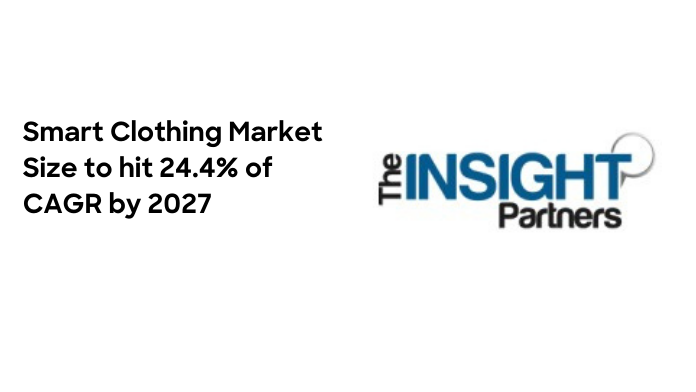The smart clothing market was valued at US$ 1.14 billion in 2019 and is expected to reach US$ 6.41 billion by 2027, growing at a CAGR of 24.4 percent between 2020 and 2027.
Report by: The Insight Partners
Smart clothing smart technology
Smart clothing is designed and manufactured with the integration of smart technologies to provide fabric with various functions.
The increasing use of smart clothing in industries such as healthcare, military, sports, and defense may have an impact on market growth in the coming years. Increasing sports-related injuries, combined with increased investments in the military and defense sectors, may drive up demand for the product. High demand for body activity monitoring via sensors may drive market expansion.
Growing consumer fitness awareness is expected to drive market growth.
Athletes’ preference for smart clothing to prevent injuries and improve performance may drive market growth during the forecast period. The global market is also expanding due to increased spending by sectors such as healthcare, sports and fitness, and the fashion industry.
| Market Size Value in | US$ 1.14 Billion in 2019 |
| Market Size Value by | US$ 6.41 Billion by 2027 |
| Growth rate | CAGR of 24.4% from 2020-2027 |
| Forecast Period | 2020-2027 |
| Base Year | 2020 |
| No. of Pages | 198 |
| No. Tables | 115 |
| No. of Charts & Figures | 96 |
| Historical data available | Yes |
| Segments covered | Type, Orientation Type, Connectivity, End-User |
| Regional scope | North America; Europe; Asia Pacific; Latin America; MEA |
| Country scope | US, UK, Canada, Germany, France, Italy, Australia, Russia, China, Japan, South Korea, Saudi Arabia, Brazil, Argentina |
| Report coverage | Revenue forecast, company ranking, competitive landscape, growth factors, and trends |
Covid-19's impact on the smart clothing market
Countries around the world have seen an unprecedented increase in the number of confirmed cases, resulting in widespread lockdowns in various regions.
Furthermore, the global pandemic had a significant impact on the service sector, resulting in a decline in services as well as layoffs across various service verticals across the distribution channel, such as retailers, suppliers, distributors, and delivery providers.
Short-term challenges for retailers and brands include health and safety, supply chain, labor force, cash flow, consumer demand, and marketing. Furthermore, the growing number of cases continues to have a negative impact on the production, distribution, and ongoing operation of the supply chain for the global smart clothing market.
Market insights- Smart clothing market
Upper Body Garment Solution Will Drive Market Growth in the Future
The rising demand for upper wear, such as smart shirts, jackets, and vests, opens up new market opportunities.
Biometric data from a smart shirt, such as heart rate, respiratory rate, and muscle activity, can be used professionally to optimize performance and workout plans. Data is collected and transmitted to all companion apps, providing insight into a variety of sporty metrics such as intensity and recovery, calories burned, fatigue level, and sleep quality. As a result, the increasing use of upper wear for various end-user applications is expected to provide opportunities for smart clothing providers during the forecast period.
Type Segment insight
Smart clothing is designed and manufactured with smart technologies integrated to provide fabric with smart functionalities.
The smart clothing market is divided into three types: passive, active, and ultra-smart clothing.
These textiles are used in a variety of applications, including providing better communication than other devices, generating electricity, analyzing and sensing stimuli, and protecting the wearer from environmental hazards.
Product segment insight
Nanotechnology and IoT are two of the most important emerging technologies driving global adoption of smart clothing. The smart clothing market is divided into four product categories: apparel, footwear, wearable patches, and others.
The ever-changing nature of human nature is a major reason for the constant updating of clothing choices and tastes.
Also read: Basketball Apparel Market Size to Grow by USD 4.58 Billion by 2026













